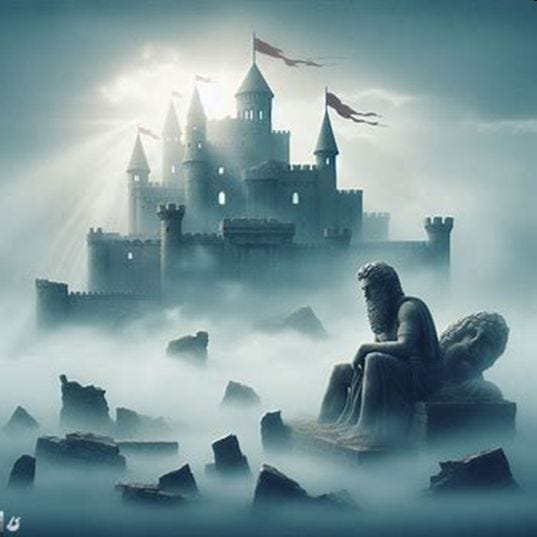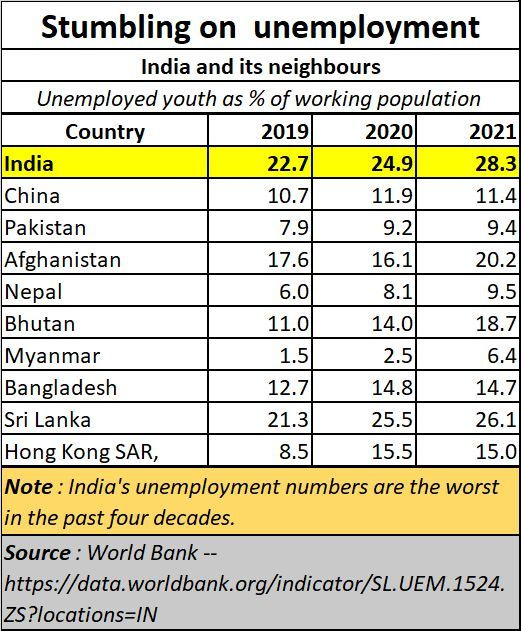Policy Watch
“My name is Ozymandias, King of Kings;
Look on my Works, ye Mighty, and despair!
Nothing beside remains. Round the decay
Of that colossal Wreck, boundless and bare
The lone and level sands stretch far away.”
Ozymandias—P.B.Shelley
In the Bing generated image above, one can see – through the mists -- a magnificent structure with flags fluttering. But Rodin’s Thinker has his eyes on shattered statues and broken pieces. History has been witness to many shattered dreams of empire builders and potentates. Often forgotten. Sometimes reviled. So, what is one to make of the huge celebrations behind Ram mandir?
To be fair, it signifies the reawakening of Hinduism. It has unified the Hindus as seldom before. But there is a sense of unease as well. Maybe, the consecration of a temple should have been left to priests not politicians.
Most mainstream media heralded the consecration ceremony as a new dawn for India. That may be so. But they often forget that new dawns become meaningful when there is economic growth as well.
Education
And this is where all celebrations fill one with dread. India is trying to mix religion with politics in much the same way as Benjamin Netanyahu’s Israel has done.
But there are three major differences.
First, Israel’s focus on religion in recent years has led to the creation of an apartheid state (see
). This should have lessons for India as well.
Second, almost everyone in Israel is well educated. This is not the case with India.
Third, as the geopolitics guru John Mearsheimer puts it, America is joined at the hip with Israel. India is not. When infractions take place, expect India to be singled out globally.
As for education, people often forget that India’s GER (gross enrolment ratio) is just 27.3 – far below the levels any education country is supposed to have (free subscription -- https://bhaskarr.substack.com/p/the-state-of-education-in-india). Its schools are poorly equipped with science laboratories and internet connectivity. And many of its schools don’t even have enough teachers.
Worse, as a recent ASER report (https://www.freepressjournal.in/education/1-in-4-high-schoolers-cannot-read-half-cannot-do-maths-aser-2023-report) showed, just 48.4% of youth (14-18 years) are capable of doing daily calculations. Is this a literate nation?
The government may proclaim that it is a Vishwa guru (teacher to the world). But education at home has been in the doldrums. No nation can aspire to wealth and greatness without education.
Employment
The second problem confronting India is unemployment. This should fill both economists and social scientists with dread and alarm. The problem is huge. India has a population of 1.4 billion, and a population growth rate of anywhere between 0.8% to 1.5% -- the government has not allowed a census to be held in 2021, hence we have only the 2011 numbers to go by. It may be recalled that between 1971 and 1981, India's population was growing at an average 2.2% each year. By 2001 to 2011, that had slowed to 1.5%. Today, the growth rate may be lower, but that is an assumption (https://www.macrotrends.net/countries/IND/india/population-growth-rate).
However, even at a 1% rate of population growth, India will need 14 million jobs for its newly born children each year. But this country has succeeded in creating barely 2-3 million jobs each year. The backlog is growing. That is why, people are migrating back from cities to their family homes in villages because they cannot find the means to bear urban expenses (free subscription -- https://bhaskarr.substack.com/p/niti-aayogs-visions-of-wealth-and?r=ni0hb&utm_campaign=post&utm_medium=web).
Poverty
The third big problem is poverty, coupled with poor healthcare systems. With declining population growth rates, India has seen an increased growth in old people. That means the demand for healthcare will become even more acute.
In some areas, life expectancy is under 40 years. The government claims it has pulled out 24.8 crore people out of poverty during the past five years, but that does not appear to be correct for reasons that were discussed in these columns last week (Free subscription -- https://bhaskarr.substack.com/p/niti-aayogs-visions-of-wealth-and?r=ni0hb&utm_campaign=post&utm_medium=web).
Symptoms
The symptoms are visible everywhere. There is a lacklustre GDP growth rate and GDP per capita as well.
When GDP growth slows down, the solution lies in boosting investments and creating employment opportunities to kickstart a virtuous cycle which leads to a higher GDP. But the government has spent increasingly large amounts of money on freebies, doles – even free food – than on improving either the investment climate, or in creating new jobs.
The results of this type of financial spending can be seen in the reduced levels of gross fixed capital formation (GFCF). The Economist has pointed this out in a chart in its recent article titled "India’s businessmen like Narendra Modi. They also fear him" January 24, 2024 (https://www.economist.com/business/2024/01/24/indias-businessmen-like-narendra-modi-they-also-fear-him).
Capital formation has slowed both in private and public sectors. True, the government has pumped in capital expenditure on highways, railways, and city development. But many of these investments cannot be said to have been wise decisions (https://open.substack.com/pub/bhaskarr/p/indias-two-dfcs-politics-trounces?r=ni0hb&utm_campaign=post&utm_medium=web).
In some cases, government owned companies have sought to go in for gold exploration overseas instead of first mining gold within India – especially where there is proof of gold reserves (https://open.substack.com/pub/bhaskarr/p/nmdcs-inexplicable-desire-to-mine?r=ni0hb&utm_campaign=post&utm_medium=web). With more attention focussed on building Ayodhya and the new parliament building, even a gold mining policy still remains to be discussed by India’s policymakers (https://asiaconverge.com/2021/01/gold-mining-series/).
Not surprisingly government deficits remain high.
Alarming FDI levels
Another symptom of all the things not done is the steep decline in foreign direct investments which currently stand at their lowest levels in 16 years (https://theprint.in/economy/why-fdi-in-india-is-lowest-in-16-yrs-no-real-ease-of-doing-business-ill-considered-treaty-moves/1927937/).
This, in turn, results in poor stock-market performance. While punters are buoyant about market growth, a careful look at the rates of market growth show that they were at their best during Narasimha Rao’s government, followed by that of A B Vajpayee, and then even the Man Mohan Singh’s government (https://open.substack.com/pub/bhaskarr/p/india-prognosis-2024?r=ni0hb&utm_campaign=post&utm_medium=web&showWelcome=true). This government does need to become more market friendly.
Added to this are several other factors that have hurt FDI sentiment. Primary among them are:
· A flawed exim policy (more details can be found at https://asiaconverge.com/2023/04/indias-confused-exim-strategy/. It has banned agricultural exports, permitted imports of some other agri commodities, and muddies the waters on the farm front. At times, it has flip-flopped over computer imports, and at other times slapped safeguard import duties even on items like solar panels.
· It has still not come to terms with the simple fact that a high import duty on gold only encourages its smuggling, thus causing both a drain on its forex reserves, and even corroding the value of its rupee (as smuggling is often paid for through the black market). Many of its policies on gold need an urgent review (
)· It has blocked investments from China in fields like Telecommunications even while countries like Vietnam and Singapore encourage this. And by banning investments from China into startups, it has grievously wounded this vibrant sector (https://open.substack.com/pub/bhaskarr/p/is-india-spooked-by-china?r=ni0hb&utm_campaign=post&utm_medium=web&showWelcome=true).
· Defying the logic put forth by senior economists like Raghuram Rajan and Arvind Subramanian, it has persisted with its PLI (performance linked incentives) which favour capital intensive industries over labour-oriented ones (https://bhaskarr.substack.com/p/dont-shun-market-allocation-of-resources?sd=pf).
· One of the biggest blows to FDI was the government’s decision to cancel all the bilateral investment treaties and forbid arbitration in international courts (https://asiaconverge.com/2020/01/arbitration-and-investment-protection/).
· It is not surprising therefore to see Indians migrating from India by surrendering their passports, and high networth individuals opting to camp outside India (
).
It is, therefore, truly sad to see FDI levels slump to their lowest in 16 years.
Conclusion
Building a temple is a great idea. It unites Hindus like never before. It could even kickstart religious tourism. But when this happens at the cost of good policy making on other fronts, and when education and health are ignored, there could be big trouble ahead.
Poverty, no jobs, little education creates NINJAs (no income, no jobs, and no assets) out of most Indians. They are willing to join any party, procession or a rent-a-mob gathering, so long as someone pays them for being there. A little twist, and violence could rent apart civil society, and plunge the country deeper in a quagmire.
It is quite probable that, spurred by the heady scent of victory, thanks to the Ram mandir, there will be mobs clamouring for more mosques to be demolished, and more temples and pilgrimage cities to be built there. If the leaders can, they should douse such passions. India should be more focussed on education, health, and jobs. Not on razing mosques and building temples.
But when religion begins to be used to distract people’s attention from other serious issues, the results could be catastrophic.
The author is a senior journalist and researcher.











Religion mingled with hate politics by power hungry politicians with no priority for economic growth will ruin the country.